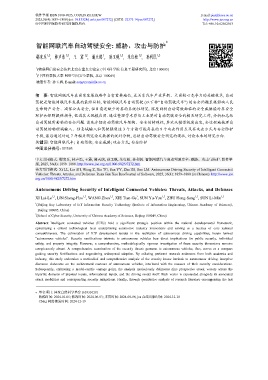Page 453 - 《软件学报》2025年第4期
P. 453
软件学报 ISSN 1000-9825, CODEN RUXUEW E-mail: jos@iscas.ac.cn
2025,36(4):1859−1880 [doi: 10.13328/j.cnki.jos.007272] [CSTR: 32375.14.jos.007272] http://www.jos.org.cn
©中国科学院软件研究所版权所有. Tel: +86-10-62562563
*
智能网联汽车自动驾驶安全: 威胁、攻击与防护
郗来乐 1,2 , 林声浩 1,2 , 王 震 1,2 , 谢天鸽 1 , 孙玉砚 1,2 , 朱红松 1,2 , 孙利民 1,2
(物联网信息安全技术北京市重点实验室 (中国科学院 信息工程研究所), 北京 100085)
1
2
(中国科学院大学 网络空间安全学院, 北京 100049)
通信作者: 孙玉砚, E-mail: sunyuyan@iie.ac.cn
摘 要: 智能网联汽车在国家发展战略中占有重要地位, 是关系汽车产业革新、大国核心竞争力的关键技术, 自动
驾驶是智能网联汽车发展的最终目标, 智能网联汽车自动驾驶 (以下称“自动驾驶汽车”) 的安全问题直接影响人民
生命财产安全、国家公共安全, 但目前还缺少对其的系统性研究. 深度剖析自动驾驶面临的安全威胁能对其安全
防护和保障提供指导, 促进其大规模应用. 通过整理学术界与工业界对自动驾驶安全的相关研究工作, 分析和总结
自动驾驶所面临的安全问题. 首先介绍自动驾驶汽车架构、安全的特殊性, 其次从模型视角出发, 全过程地梳理自
动驾驶的物理域输入、信息域输入和驾驶模型这 3 个方面可能存在的 9 个攻击作用点及其攻击方式与安全防护
手段, 最后通过对近 7 年相关研究论文数据的统计分析, 总结自动驾驶安全研究的现状, 讨论未来的研究方向.
关键词: 智能网联汽车; 自动驾驶; 安全威胁; 攻击方式; 安全防护
中图法分类号: TP393
中文引用格式: 郗来乐, 林声浩, 王震, 谢天鸽, 孙玉砚, 朱红松, 孙利民. 智能网联汽车自动驾驶安全: 威胁、攻击与防护. 软件学
报, 2025, 36(4): 1859–1880. http://www.jos.org.cn/1000-9825/7272.htm
英文引用格式: Xi LL, Lin SH, Wang Z, Xie TG, Sun YY, Zhu HS, Sun LM. Autonomous Driving Security of Intelligent Connected
Vehicles: Threats, Attacks, and Defenses. Ruan Jian Xue Bao/Journal of Software, 2025, 36(4): 1859–1880 (in Chinese). http://www.jos.
org.cn/1000-9825/7272.htm
Autonomous Driving Security of Intelligent Connected Vehicles: Threats, Attacks, and Defenses
1
1,2
1,2
1,2
1,2
1,2
XI Lai-Le , LIN Sheng-Hao , WANG Zhen , XIE Tian-Ge , SUN Yu-Yan , ZHU Hong-Song , SUN Li-Min 1,2
1
(Beijing Key Laboratory of IoT Information Security Technology (Institute of Information Engineering, Chinese Academy of Sciences),
Beijing 100085, China)
2
(School of Cyber Security, University of Chinese Academy of Sciences, Beijing 100049, China)
Abstract: Intelligent connected vehicles (ICVs) hold a significant strategic position within the national developmental framework,
epitomizing a critical technological facet underpinning automotive industry innovations and serving as a nucleus of core national
competitiveness. The culmination of ICV development resides in the realization of autonomous driving capabilities, herein termed
“autonomous vehicles”. Security ramifications intrinsic to autonomous vehicles bear direct implications for public security, individual
safety, and property integrity. However, a comprehensive, methodologically rigorous investigation of these security dimensions remains
conspicuously absent. A comprehensive examination of the security threats germane to autonomous vehicles, thus, serves as a compass
guiding security fortifications and engendering widespread adoption. By collating pertinent research endeavors from both academia and
industry, this study undertakes a methodical and comprehensive analysis of the security issues intrinsic to autonomous driving. Inceptive
discourse elaborates on the architectural contours of autonomous vehicles, interlaced with the nuances of their security considerations.
Subsequently, embracing a model-centric vantage point, the analysis meticulously delineates nine prospective attack vectors across the
tripartite domains of physical inputs, informational inputs, and the driving model itself. Each vector is expounded alongside its associated
attack modalities and corresponding security mitigations. Finally, through quantitative analysis of research literature encompassing the last
* 基金项目: 国家自然科学基金 (61931019)
收稿时间: 2024-01-05; 修改时间: 2024-06-03; 采用时间: 2024-08-06; jos 在线出版时间: 2024-12-18
CNKI 网络首发时间: 2024-12-19

